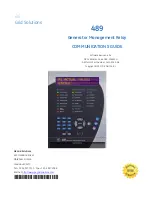
IL04915001E
Effective 7/09
3
1.6 Operating Modes
The D64RPB30 has four distinct Operating
Modes. All modes have this in common:
- In the ‘reset state’ of the relay the normally
open contact is open and the normally closed
contact is closed.
- In the ‘tripped state’ of the relay the normally
open contact is closed and the normally
closed contact is open.
The different modes are:
1. Continuous Non-Failsafe operation
After a trip the relay remains in the tripped
state and the red LED remains active until
the reset button is pressed. When control
voltage is removed the relay goes to the
reset state unconditionally.
2. Continuous Failsafe operation
Same as mode 1, except when control
voltage is removed the relay goes to the
tripped state unconditionally.
3. Pulsed Non-Failsafe operation (for shunt
controlled breakers, or alarm only purposes)
When a trip occurs, the relay goes to the
tripped state for 0.5 seconds, then resets.
Regardless of the cause of trip, should
measured current remain or go above the set
G/F trip level, this pulse is repeated every 3
seconds. The red LED remains active until
the reset button is pressed. This allows the
user to verify which D64RPB30 tripped its
associated breaker. If the reset button is not
pressed (LED continues to show cause of
trip), the functionality of the trip circuit is not
compromised. That is, in case of a trip
condition the relay will correctly issue a
pulse, even if the red LED is active.
When control voltage is removed the relay
will not issue a pulse (but note that this will
reset the red LED).
4. Pulsed Failsafe operation (for shunt
controlled breakers, or alarm only purposes)
Same as mode 3, except when control
voltage is removed the relay will issue a 0.2-
0.3 second pulse. This means that, when
control voltage is restored after a trip due to
loss of control voltage, the contact will remain
open. This avoids the 500 ms delay in
contact transfer that occurs when control
power is restored on continuous failsafe
operation (in 2 above).
If the D64RPB30 is to be used for alarm only
purposes (rather than to interrupt ongoing
processes), and the alarm has to have an auto-
resetting operating mode, select one of the
Pulsed modes. The pulses will be repeated as
long as current is above the set G/F level. Note
that a faulty connection of the external CT would
only generate one pulse. Also, note that with
Ground faults the red LED will always show the
‘trip failed’ alarm.
1.6 Tamper proof dipswitches
Eight dipswitches are used to program the
D64RPB30. However, to discourage
unauthorized manipulation, the preselected
settings can only be changed by going through
the procedure outlined below.
When an attempt is made to change the settings
without going through this procedure, the green
and red LEDs start to blink alternately until the
switches are returned to their original positions.
Should the switches be left in other than the
preselected settings, the preselected settings,
being stored in non-volatile memory, remain
valid.
The proper procedure to change settings is as
follows:
1. The dipswitches are placed in the new
positions (ignoring the blinking LEDs).
2. Within 15 seconds after the last change was
made (or control power was applied), the
system is brought in test mode using the
local pushbutton, causing the new settings to
become active. Since the system will trip
now, changing the settings cannot go by
undetected. See section 1.4 for a description
of how to invoke test mode.
Note that any trips must be reset before this
procedure can be completed.




















